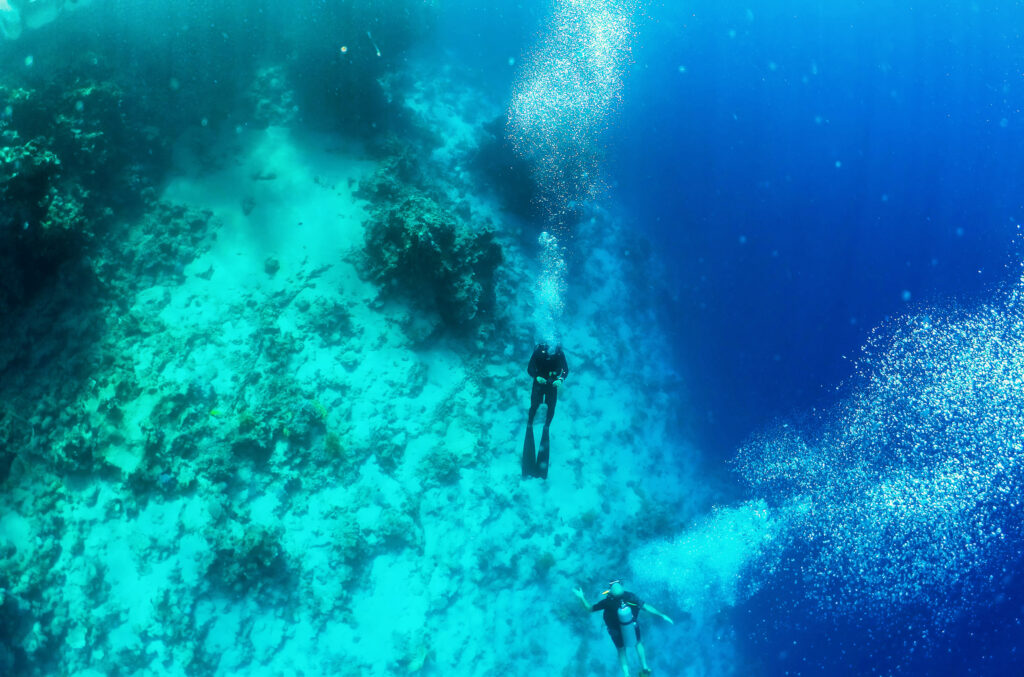What is a Purge?

In scuba diving, the term “purge” refers to the mechanism used to expel water from certain pieces of diving equipment, primarily diving masks and regulators. The ability to quickly and efficiently remove water from these components is crucial for ensuring clear vision and unimpeded breathing underwater. The concept of purging has evolved significantly over the years, becoming an integral part of modern scuba gear. Understanding the function and proper use of purge systems is essential for divers at all levels, as it directly impacts safety and comfort during underwater excursions.
What is Rapture of the Deep?

Rapture of the Deep, commonly known as nitrogen narcosis, is a condition experienced by scuba divers at significant depths. This phenomenon, resulting from the increased partial pressure of nitrogen when diving, can lead to a range of symptoms that affect cognitive and motor functions. Understanding Rapture of the Deep is crucial for divers to ensure safe practices and avoid potentially hazardous situations underwater.
What is Vertigo?

Vertigo, a sensation of spinning or dizziness, can significantly impact one’s sense of balance and orientation. In the context of scuba diving, this condition becomes particularly relevant and potentially hazardous. Divers who experience vertigo underwater may struggle with maintaining their equilibrium, which can lead to disorientation and dangerous situations. This article delves into the causes, impacts, diagnosis, prevention, and management of vertigo specifically for scuba divers.
What is “Out of Air”?

In the context of scuba diving, “out of air” refers to a situation where a diver has depleted their air supply, presenting a critical emergency. This term underscores the paramount importance of air management for diver safety. Proper planning, vigilance, and awareness are essential to prevent such incidents, as running out of air underwater can lead to severe consequences, including drowning. Understanding the factors that contribute to air depletion and the measures to prevent and handle such emergencies is crucial for every diver.
What is No Fly / No Fly Time?

No Fly Time, also referred to as No Fly Zone or No Fly Period, is the recommended interval between the completion of a dive and boarding an airplane. It is an essential precautionary measure that helps prevent Decompression Sickness (DCS) and other altitude-related issues that may arise from flying too soon after scuba diving. The importance of observing No Fly Time stems from the physiological effects of pressure changes on the body, both during diving and air travel. Failure to allow sufficient time for these changes to normalize can lead to serious health complications.
What is a Low Pressure Inflator?

The Low Pressure Inflator (LPI) is a crucial component in scuba diving equipment, connecting a diver’s buoyancy control device (BCD) to their air supply. It allows divers to control their buoyancy underwater, making it an essential tool for maintaining stability and comfort during dives. By pressing the inflator button, divers can add air to their BCD, making them more buoyant, while the deflator button allows them to release air, decreasing buoyancy. This control over buoyancy is vital for safe and enjoyable diving experiences.
What is Partial Pressure?

Partial pressure is a fundamental concept in physics and chemistry, particularly significant in the context of scuba diving. It refers to the pressure exerted by a single type of gas in a mixture of gases. Understanding partial pressure is crucial for divers as it influences how gases are absorbed, transported, and expelled in the human body under varying underwater conditions. This concept helps in comprehending how different gases behave under increased pressures encountered at depth and is essential for ensuring safety and preventing diving-related illnesses.
What is Open Water Diving?

Open water diving is a fundamental form of recreational scuba diving, characterized by diving in natural bodies of water such as oceans, seas, and lakes. Unlike confined water diving, which takes place in controlled environments like swimming pools, open water diving offers divers the opportunity to experience the vastness and diversity of underwater ecosystems. This type of diving typically involves greater depths and more variable conditions, making it both a thrilling and challenging pursuit for enthusiasts of all levels. The concept of open water diving is integral to the sport, providing the foundation for various specialized diving activities and advanced certifications.
What is Samba in Scuba Diving?

Samba, in the context of scuba diving, refers to an involuntary muscle spasm or twitching that occurs as a warning sign of impending hypoxia or loss of consciousness underwater. This condition is crucial for divers to recognize because it serves as a precursor to more serious and potentially life-threatening situations such as blackouts. Understanding samba and its implications can significantly enhance diver safety and preparedness, ensuring that appropriate actions are taken promptly to mitigate risks. While samba is less commonly discussed than other diving conditions, its impact on diver health and safety is equally important.
What is a Pressure Gauge?

A pressure gauge is an essential instrument in scuba diving, designed to measure and display the pressure of the air supply within a diver’s tank. This device is crucial for ensuring that divers are aware of their remaining air, thereby allowing them to manage their breathing and plan their ascent to the surface safely. Without a reliable pressure gauge, a diver risks running out of air underwater, which could lead to potentially life-threatening situations. Thus, understanding the function and importance of pressure gauges is fundamental for anyone involved in scuba diving.
